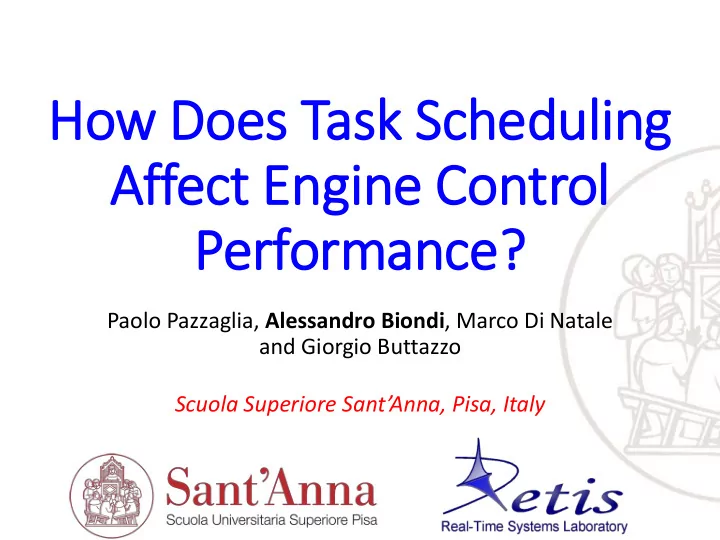

How Does Task Scheduling Affect Engine Control Performance? Paolo Pazzaglia, Alessandro Biondi , Marco Di Natale and Giorgio Buttazzo Scuola Superiore Sant’Anna , Pisa, Italy
2 A. Biondi – RTSOPS 2016
INTRODUCTION • Engine control is a very interesting and challenging CPS problem • Scheduling plays a key role • Design constraints (limited computational power) • Timing significantly influences system performance • Both time- and event-driven behavior 3 A. Biondi – RTSOPS 2016
ENGINE CONTROL APPLICATIONS • Engine control applications include • Periodic Tasks , with fixed periods (1-500 ms) • Angular Tasks , linked to the rotation of the crankshaft activate task ( t ) 2 3 / 2 / 2 t 10-120 ms Task activations t 4 A. Biondi – RTSOPS 2016
ADAPTIVE BEHAVIOUR To prevent overload at high rates, different control implementations are used time speed 3 2 1 time WCET C( 1 ) C( 2 ) C( 3 ) 1 2 5 A. Biondi – RTSOPS 2016
ENGINE CONTROL APPLICATIONS CPU ECU 6 A. Biondi – RTSOPS 2016
SCHEDULING PROBLEM Periodic computational activities Periodic Real-Time Tasks – Studied since 70’s Engine-triggered computational activities AVR Tasks – Studied only in the last years Buttazzo et al. DATE14 Davis et al. RTAS14 Biondi et al. ICCPS15 Guo and Baruah ICCPS15 7 A. Biondi – RTSOPS 2016
ALL THE SOLUTIONS FOR THE SCHEDULING PROBLEM ASSUMED HARD DEADLINES Are engine control applications hard real-time ?
THE (REAL) PROBLEM • Engine control is not hard real-time Deadline misses can be tolerated • Informal specifications • “Deadline can be missed but not that many ” • “Not that many consecutive deadline misses” • “Not that large maximum response - times” • “What matters is the engine performance ” • “The system incurs in transient overloads ” 9 A. Biondi – RTSOPS 2016
THE (REAL) PROBLEM • The objective of the scheduling is not necessarily to meet al the deadlines . BUT Maximize the engine performance given a set of computational constraints Engine control is a complex multi-criteria design optimization problem ( power, fuel efficiency, noise, emissions,… ) 10 A. Biondi – RTSOPS 2016
EXAMPLE OF CHALLENGES FUEL INJECTION Angular Trigger Injector Engine Latch plant TPU CPU • TPU uses data produced from the CPU (injection angle, quantity of fuel , CR pressure…) If deadlines are missed (on the CPU ), the TPU uses old data for the next injection 11 A. Biondi – RTSOPS 2016
EXAMPLE OF CHALLENGES FUEL INJECTION • Deadline misses can be penalizing if the conditions of the engine changed (too much) from previous cycles. • The use of old data can produce errors in the injection angle . Scheduling errors Inaccurate injection Decreasing performance 12 A. Biondi – RTSOPS 2016
EXAMPLE OF CHALLENGES SWITCHING SPEEDS • To prevent overload conditions, different control implementations are used depending on the engine speed Engine-triggered Task ~ controller controller controller C controller fuel injections 13 A. Biondi – RTSOPS 2016
EXAMPLE OF CHALLENGES SWITCHING SPEEDS C C #1 C C C C #2 C C C #3 ~ C #N C C 14 A. Biondi – RTSOPS 2016
EXAMPLE OF CHALLENGES SWITCHING SPEEDS • Which is the best speed to switch control implementation? • The problem has been recently attempted only under the assumption of hard deadlines … WCET( 𝜕 ) Most complex simplified control implementations implementation giving lower performance impl. #2 impl. #3 impl. #4 𝜕 𝜕 𝑛𝑏𝑦 𝜕 𝑛𝑗𝑜 𝜕 3 𝜕 1 𝜕 2 15 A. Biondi – RTSOPS 2016
TODAY’S APPROACH: ITERATIONS BETWEEN TEST-BENCH AND TUNING “Something” more systematic supported by a model and an analysis would be very useful …
CAN THE PROBLEM BE PARTITIONED? • Is it possible to separate the timing ( scheduling ) problem from the functional ( performance ) analysis? Metrics/Parameters Timing Performance Analysis Analysis Performance functions 17 A. Biondi – RTSOPS 2016
EXISTING APPROACHES Firm real-time (e.g., m-k model) • Still yes/no analysis; • No way to express impact on performance. Generalized response-time analysis • Allows computing max. number of consecutive deadline misses; • System state not considered; • No way to express impact on performance. Value-based scheduling • Allows expressing performance as value functions; • How to obtain (and define) value functions? • Value should be dependent on the system state. 18 A. Biondi – RTSOPS 2016
LIMITATIONS • None of the existing approaches can be used as it is . • Possibly a combination of such techniques will be required. Large lack of models (and corresponding analysis techniques) to take into account the system state (and hence performance ) 19 A. Biondi – RTSOPS 2016
SCHEDULING AS DESIGN OPTIMIZATION Scheduling in engine control should be a design optimization of performance functions PROBLEMS • Likely, performance cannot be expressed as a simple function of timing parameters. • Performance is not independent from past behavior . • Multiple performance indexes must be considered. 20 A. Biondi – RTSOPS 2016
OUR (CURRENT) APPROACH • Closed form functional mapping between temporal parameters and performance is possible for simple control systems. • This approach becomes soon prohibitively difficult for a realistic CPS due to the intrinsic complexity of the system. Our attempt Use a simulation framework 21 A. Biondi – RTSOPS 2016
OUR (CURRENT) APPROACH Simulink architecure Control Control Unit laws Engine Sensors model Simulink Scheduler interface Actuation External Scheduling Simulator 22 A. Biondi – RTSOPS 2016
Thank you! Alessandro Biondi alessandro.biondi@sssup.it
Recommend
More recommend